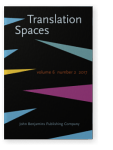Sociocultural Transformations
The nomenclature of storms in Arabic
From Arabicisation to adaptation
This article deals with the naming of ecology-related objects in Arabic, as illustrated in the naming of the snowstorms “Storm Huda”, “Storm Jana” and “Storm Zina” which whipped through the Middle East countries on January 6 and February 19, 2015 respectively. The article analyses a corpus of headlines taken from four online newspapers and one news agency, examines the strong connotative values of the snowstorm names, and discusses their relations to translation. The findings of the study show a consensus amongst journalists and meteorologists in Palestine, Jordan, Syria and Saudi Arabia to avoid Arabicisation and opt instead for a full adaptation of foreign storm names in line with the poetics of the receiving culture, one seemingly infused with several echoes from Arab-Islamic culture and particularly the Qur’an. The meticulous care in their choice of words is fully compatible with the perceived target language (TL) audience belonging to Arab-Islamic culture, one with little affinity to English culture.
Article outline
- 1.Introduction
- 2.The nomenclature of storms in English and Arabic
- 3.Translation problems
- 4.Translation strategies
- 5.Arabicisation
- 6.Adaptation
- 7.Methodology
- 8.Data used in the study
- 9.Significance of the study
- 10.Discussion and analysis
- 11.Implications for translators
- 12.Concluding remarks
- Notes
-
References
This article is currently available as a sample article.
References
Al-Hamad, Mohammad Qasem
2014 “
The Translator in Strange Lands”.
International Journal of Humanities and Social Science 4(3): 199–209.

Al-Najjar, Majed
1989 “
Linguistic Methods for Translating non-Arabic Signifiers into Arabic.”
Issues in Translation, 77–94.

Ali, Abdullah Yusuf
1989 The Holy Qur’an: Text, Translation and Commentary. Brentwood, MD: Amana Corporation.

Aljazeera Net
Retrieved on 11 October 2015 from
[URL].
Alriyadh
Retrieved on 11 January 2015 from
[URL].
An-Nahar
Retrieved on 11 January 2015 from
[URL]-.
Arab News
Retrieved on 11 January 2015 from
[URL].
Ath-Tha‘ālibi, A. M.
1972 Fiqh al-Lugha wa-Siru al-‘Aarabiyya [
Philology and Secrecy of Arabic]. Cairo: Mustafa il-Babi il-Halabi.

Bassnett, Susan
2002 Translation Studies. London: Routledge.

Beekman, John and John Callow
1974 Translating the Word of God. Michigan: Zondervan.

Burke, Peter and R. Po-chia Hsia
(eds) 2007 Cultures of Translation in Early Modern Europe. Cambridge University Press.


Farghal, Muḥammad and Abdulla Shunnaq
1999 Translation with Reference to English and Arabic: A Practical Guide. Jordan: Dar Al-Hilal for Translation.

Ibn Manẓūr, A. M.
2015 Lisan al Arab. Retrieved on 25 February 2016 from
[URL].
Kelly, Louis
1979 The True Interpreter: Theory and Practice of Translation in the West. Oxford: Blackwell.

Maʻan News Agency
Retrieved on January 7, 2015. from
[URL].
Maʻan News Agency
Retrieved on January 7, 2015. from
[URL]
Maʻan News Agency
Retrieved on August 8, 2015 from
[URL].
Manser, Martin H.
2007 The Facts on File Dictionary of Proverbs. New York: Infobase Publishing.

Mizher, Rabab Ahmad, and Fawwaz Al-Abed Al-Haq
2014 “
Attitudes Towards Using Standard Arabic among Academic Staff at Balqa Applied University/Center in Jordan: A Sociolinguistic Study.”
International Journal of English Linguistics 4(1): 53.


Newmark, Peter
1988 A Textbook of Translation. New York: Prentice Hall.

Potter, Sean
2005 “
Name that Storm: From Blizzards to Tornado Outbreaks. There Is More Than One Way to Play The Storm Name Game.”
Weatherwise 58(1): 24–29.


Pym, Anthony
2010 Translation and Text Transfer: An Essay on the Principles of Intercultural Communication. Frankfurt am Main: Peter Lang.

Robinson, Douglas
1997 Becoming a Translator: An Introduction to the Theory and Practice of Translation. Routledge.

Salloum, Habeeb and James Peters
1996 Arabic Contributions to the English Vocabulary: English Words of Arabic Origin: Etymology and History. Librairie du Liban Publishers: Beirut.

Scott-Tennent, Christopher, María González Davies, and Fernanda Rodríguez Torras
Shammaa, Tarek
2009 “
Translating into the Empire. The Arabic Version of Kalila wa Dimna.”
The Translator 15(1): 65–86.


Shehab, Ekrema
2009 “
The Problems Involved in Translating Arabic Cognitive Synonyms into English.”
The Islamic University Research Journal 17(1): 869–890.

Shunnaq, Abdullah
1993 “
Lexical Incongruence in Arabic-English Translation Due to Emotiveness in Arabic.”
Turjman 2(2): 37–63.

Shunnaq, Abdullah
2012a Papers and Studies in Arabic Translation. Irbid: Yarmouk University Publications.

Shunnaq, Abdullah
2012b “
Glimpses on the translation movement in Jordan.” in
Proceedings on Contemporary Academic Research. The 2nd International Conference. Department of English Language and Translation Zarqa University.

Shuttleworth, Mark and Moira Cowie
1997 Dictionary of Translation Studies. St. Jerome Publishing.

Stevenson, Charles Leslie
1963 Facts and Values. Yale: Yale University Press.

Suliman, Hassan Sayed
2014 “
The First Political Systems in the Independent Maghrib (A Comparative Study).” Retrieved on 30 September 2015 from
[URL].
Thawabteh, Mohammad
2007 Translating Arabic Cultural Signs into English: A Discourse Perspective. Doctoral dissertation, unpublished. Granada: University of Granada.

The Jordan Times
Retrieved on 30 September 2015 from
[URL].
Toury, Gideon
1984 “
Translation, Literary Translation and Pseudotranslation.”
Comparative Criticism 61: 73–85.

Ullmann, Stephen
1983 Semantics: An Introduction to the Science of Meaning. Basil Blackwell Publisher Limited.

undp
2003 The Arab Human Development Report 2003, Building a Knowledge Society. New York: United Nations Publications. Retrieved on 30 September 2015 from
[URL].

Venuti, Lawrence
1995 The Translator’s Invisibility. London & New York: Routledge.


Weather online
History of Hurricane Names. Retrieved on 11 April 2016 from
[URL].
Cited by
Cited by 1 other publications
This list is based on CrossRef data as of 18 june 2024. Please note that it may not be complete. Sources presented here have been supplied by the respective publishers.
Any errors therein should be reported to them.
